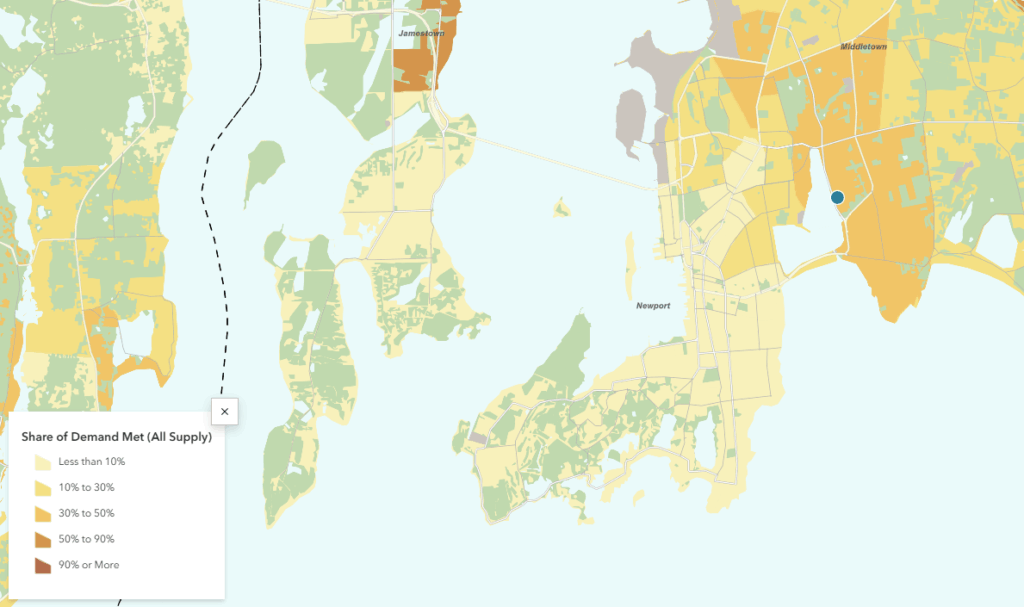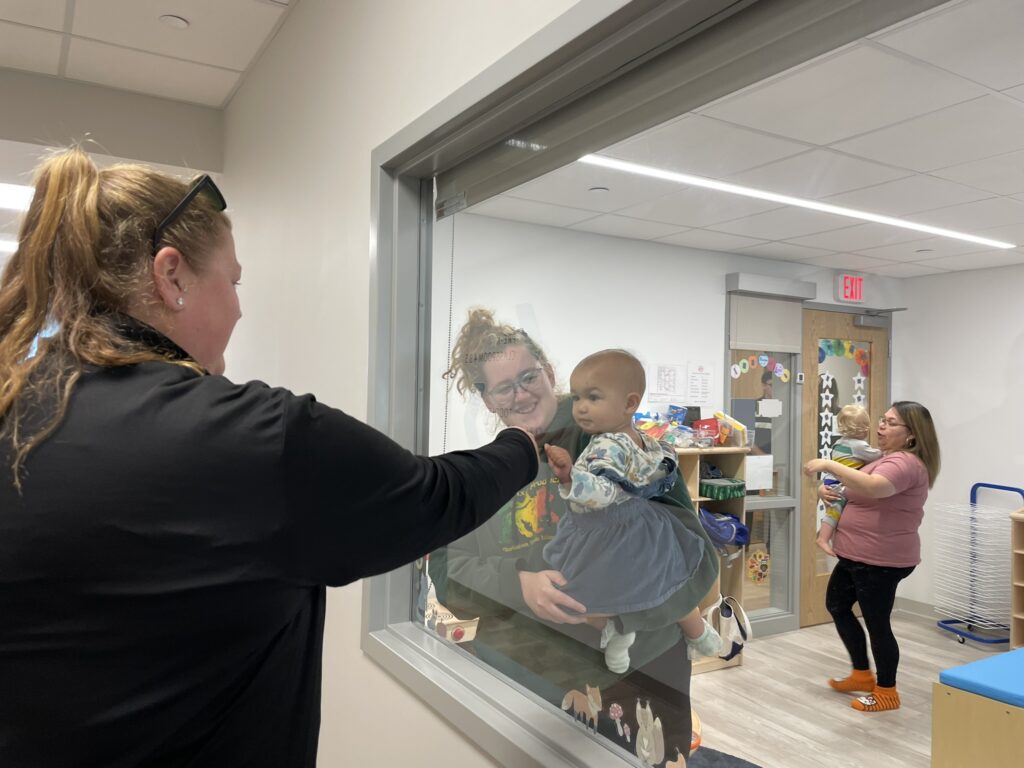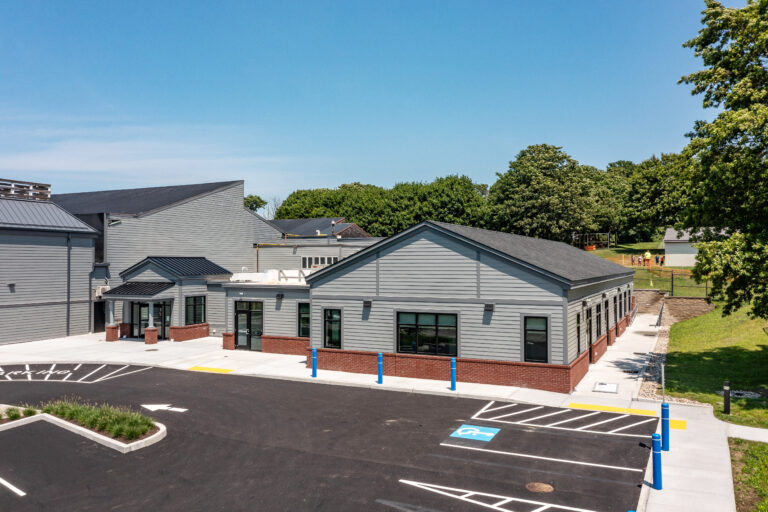The Early Childhood Care and Education (ECCE) Capital Fund program was a state general obligation bond-funded grant program providing more than thirteen million dollars ($13,000,000) in funding for physical improvements to existing child care spaces and for the development of new licensed early childhood care and education facilities. This program was approved by voters in a March 2021 special election and administered by LISC’s Rhode Island Child Care and Early Learning Facilities Fund (RICCELFF) in partnership with the Department of Human Services (DHS).
In 2016, Newport County YMCA CEO Mike Miller and the team at Twice as Nice Preschool, led by Senior Director of Youth Development, Andrea Florendo, started working with the RICCELFF on a possible expansion project – not imagining that it would be a reality less than 10 years later. Before significant funding was available through the Early Childhood Care and Education (ECCE) Capital Fund, the RICCELFF provided other resources to assist the YMCA team in their commitment to quality early childhood care. The YMCA used Preschool Development Grant (PDG) planning funds to hire an architect to create potential design plans for an expanded child care facility years before it was financially possible. In addition, a LISC and AmeriCorps Day of Service brought volunteers to the site to complete outdoor space improvements for the children’s play area.
A Child Care Facilities Assessment was conducted in 2019 as part of a long-standing, ongoing partnership between LISC and DHS that offers funding and technical assistance for child care providers in Rhode Island. The data from the Assessment and other sources have been visualized in a StoryMap resource. The Assessment found a significant lack of child care seats in Rhode Island overall, although there are a few communities that face particularly serious shortages, including Newport, which has a much higher shortage relative to other Rhode Island communities. Many of the neighborhoods surrounding the Newport County YMCA do not have enough child care seats of any quality for even 10% of children, with several areas having no high-quality seats at all. At the ribbon cutting for the new facility, Nicole Chiello, Associate Director – Office of Child Care at DHS, recognized the importance of targeting investment in these high-needs areas, saying, “This side of the bridge is quite the child care desert, so nothing makes me happier than knowing that quality programs like this one are expanding and taking in more children who need it.”

When the competitive application for ECCE Capital Fund dollars opened, the Twice as Nice team was prepared to enact their vision from years before. Despite a huge project, which combined renovation and expansion to improve 50 slots and create 44 more, including 29 new infant and toddler slots, the existing plans from the PDG program and ongoing technical assistance conversations with the RICCELFF team allowed them to submit a robust application for funds. The project was awarded more than $3 million.
The project was a community effort, involving seven funders (plus two more for an upcoming playground renovation), providing more than $5 million with ECCE Capital Fund money, covering nearly 75% of the total cost of construction. Newport County YMCA CEO, Mike Miller, explained that the YMCA’s close relationship with the RICCELFF and its technical experts increased other funders’ trust in their ability to complete a high-quality project.
Emphasizing the importance of technical assistance, Senior Program Officer, Erin Cox, AIA of LISC said, “I think the backbone of what works for LISC, and why we’re different than other funders, is that we want to build long-term relationships with our partners. It really is part of our approach and it’s important to us that we’re not just providing funding. We operate through technical assistance so we can work alongside our partners through an entire project, and hopefully beyond.”

Space is more than just what’s necessary for fitting more children into care. Thoughtful design is important too, as it impacts all people in the space, from providers to children to families. At the ribbon cutting ceremony for the center expansion, Miller recognized the importance of design for their program: “Andrea [Florendo] always ran a quality program, but the space did not represent the program, the space that we had. And now we have a quality space just to pay tribute to the program that [she] always ran, and now [we] can double that capacity and more families can enjoy that.”
Some intentional design choices may seem small, but they have an outsized impact on the programming. The PDG funds utilized by the YMCA allowed them to hire professionals from Providence-based Vision 3 Architects, a firm that has specialized expertise in child care spaces and high-quality child care facility design. Throughout the space, classrooms are larger than licensing requirements require, and providers can adjust lighting through dimmer switches and windows with natural light. Dishwashers were placed in the infant classrooms for the convenience of the providers and the safety of the children. Staff have their own bathroom. Interior windows between the classrooms and the hallways allow natural light to reach the space, and low windows at children’s height facilitate interaction between people in the hallway and children inside the classrooms. When the providers were asked to give feedback about the design plans for the new space, they expressed that they preferred muted accent walls over a busy mural, so they could decorate their classroom as they wished. Now, every classroom has its own personality that reflects the providers and children who learn there.

The large, multipurpose lobby provides flexibility for providers and parents: it has been used as a play space, indoor gross motor space in inclement weather, a quiet area for counseling, speech and occupational therapy, and a community event space. Parents often utilize the space to ease their children’s transition into care. Florendo explained that parents “definitely do love that lobby! They use it to get their kids ready in the morning. Sometimes it’s a struggle, so they’ll let them play for a few minutes and then say, ‘okay, you have 3 minutes, and then we’re going to go check in.’ And that seems to work. And then they do the same at the end of the day as well.” This practice can help reduce challenging behaviors in the classroom. Large, colorful sand timers have been added to the lobby to support parents who use it as a transition space.
Miller, Florendo, and team prioritized staff, family, and child wellbeing despite rising construction costs. After costs rose much higher than they had planned for in their original fundraising campaign, they did everything they could to reduce costs without reducing quality. The project contractor, Farrar & Associates, reduced costs by almost $1 million through a process of value engineering, which involved swapping certain materials for less expensive alternatives, like using wood instead of steel, and reducing fixtures, like cabinetry. Through a contract amendment, LISC awarded additional funds from the ECCE Capital Fund pool to decrease the impact of cost overruns on the project.

Ultimately, the combination of value engineering and additional funds meant that the number of seats for children remained the same. Florendo noted that, while they could have opened the current infant/toddler spaces to a larger number of older children per room and increase revenue, it was a priority to care for the youngest children: “It’s [about] even more than just capacity, it’s about what age groups you’re accepting, and I just think that’s huge. Our wait list is so long [because] we’re accepting infants.” The 2019 Facilities Assessment found that Rhode Island is experiencing a particularly dire shortage of infant/toddler care, which follows a nationwide pattern. The new rooms at the YMCA can care for up to 29 infants and toddlers – and they are fully enrolled. Despite the cost, Twice as Nice used the expansion to open infant classrooms for the very first time and meet the community’s needs.
The overall YMCA community has been impacted too. The lobby play area has become an opportunity for parents and caregivers to connect with one another while their children play. “It’s more than just a place for child care,” Miller says. “It’s a community hub.” It’s part of the YMCA model that brings the community together, and there are future improvements on the horizon to continue encouraging families to gather. The program at Twice as Nice also builds community by offering free swim lessons to enrolled preschoolers.

Cox expressed that the funders of this project recognize that “quality child care space is an important part of the funding system for economic development in the state. Because of these investments, not only will children and their families have a great place to be for early learning, which will impact them for years and years to come, but our workforce is impacted too. We’re providing a great space for people to come work in every day as well.” After the expansion, Twice as Nice hired 12 new full-time staff members, more than doubling their previous staff of 10. All of these staff members have access to benefits like healthcare, a retirement plan with employer match, and paid time off, as well as a brand-new facility to support their everyday needs in the classroom.
The benefits of a significant infrastructure project like the one at Twice as Nice extend past children and providers to their families, the workforce, and the community. When done right, large undertakings require years of planning, technical assistance, expertise, and design among a dedicated multidisciplinary team committed to making a difference. As the largest investment of the ECCE Capital Fund program, the Twice as Nice Preschool renovation had the longest timeline; its current outcome was almost ten years in the making. It takes a substantial amount of trust and relationship-building between many individuals, companies, and organizations to make amazing things like this happen—and that takes time.
Miller and his team aren’t deterred by the effort, though. The project’s success has already motivated donors to provide an additional $.5 million to renovate the outdoor play space that was torn up to make the expansion a reality, and the YMCA continues to make improvements. Miller says that the drive to keep improving is possible because of partnerships with organizations like LISC and funding like the ECCE Capital Fund: “We would not be sitting here today without the [ECCE Capital] Fund, without that award…And here we are, impacting so many here in in Newport County and the kids and families…And that’s what we’re excited about—a lasting impact for generations to come.”

